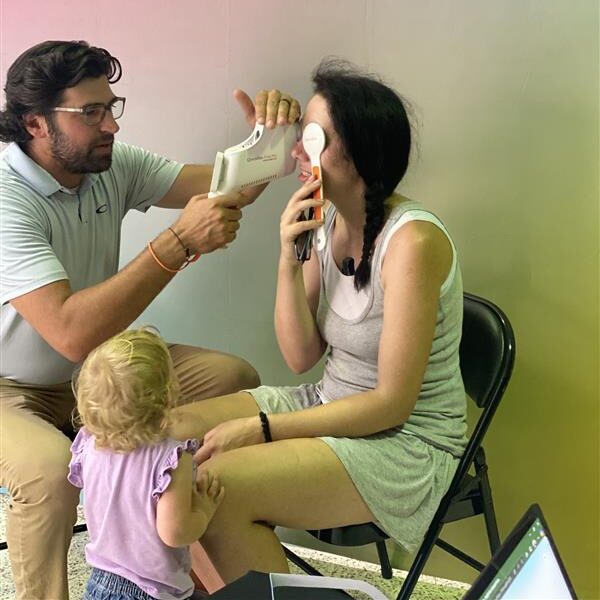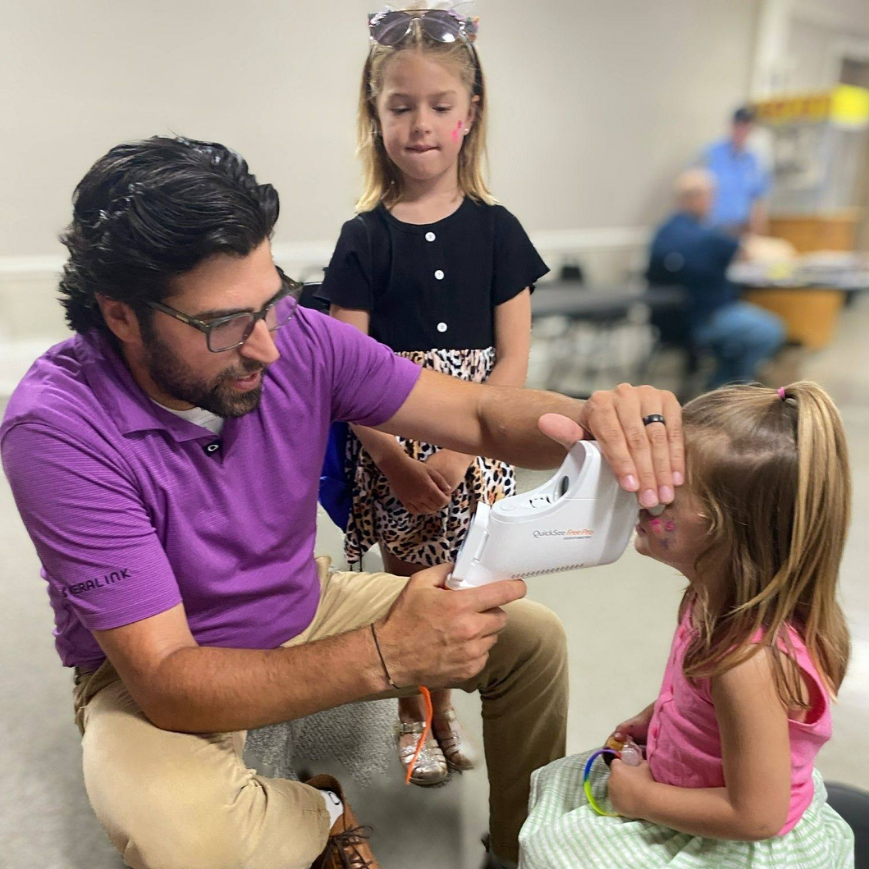KeraLink International recently participated in two community health fairs in rural Michigan, reaching hundreds of attendees with vision education and screening services. In total, two KeraLink team members screened about 20 percent of attendees, and the results underscored just how critical access to affordable eye care remains.
Nearly 81 percent of participants had not received an eye exam in the past year. For some, it had been close to a decade. One participant even shared that she had been wearing the same pair of glasses for 20 years.
Meet Jessica

Photo: Jessica with her daughter as KLI Director of Strategic Partnerships & Initiatives provides a vision screening.
Among those screened was Jessica, a mother balancing the care of her young daughter while managing significant vision challenges of her own.
Jessica’s own mother recalled a moment from Jessica’s childhood that revealed her vision problems. At just three years old, while attending an airshow, Jessica’s mother pointed to the sky and said, “Look at the airplanes!” Jessica’s reply was simply, “What planes, Mama?” That moment led to her first eye exam.
Now 35, Jessica told us her current glasses still were not helping her see far away. Her prescription is around minus seven, but our screening suggested she may require additional power. To put that into perspective, when asked to focus on a poster about ten feet away, she could not see it at all, saying it simply “blended in with the background.”
In that moment, three generations were connected by the same thread — a mother guiding her child toward sight. What began decades ago with the words “What planes, Mama?” has come full circle as KeraLink works to ensure Jessica’s daughter will grow up seeing the world her mother once struggled to see.
What the Screenings Revealed
Photo: [Volunteer using QuickSee Free Pro device with participant]
Behind every number was a story. More than half of those screened had vision insurance, yet nearly three quarters still told us they would struggle to afford glasses.
Many shared health histories that carried weight — almost half reported personal or family experiences with conditions such as diabetes, cataracts, glaucoma, or hypertension. Vision challenges were common and often disruptive, from squinting and headaches to trouble seeing up close or far away. Nearly half were already living with symptoms that touched their daily lives, shaping the way they worked, learned, and connected with others.
Each story underscored the same truth: clear vision is not a luxury; it is a lifeline. It is this understanding that drives KeraLink’s partnerships and collaborative efforts to expand access and care.
Collaboration in Action

Dr. Nelson Edwards, Director and President of VOSH Michigan, made a four-hour round trip to join our first day of screenings in Michigan, a testament to the power of collaboration in reaching underserved communities. Screenings are a valuable way to identify people who may need vision correction, but they are not a substitute for a comprehensive eye exam. Only an eye doctor can fully assess eye health, safely provide a prescription, and detect signs of conditions, often before symptoms appear. Dr. Edwards took this opportunity to network with our team and discuss potential collaboration, which we are excited to pursue. Our ongoing partnership discussions are being led by VOSH Executive Director Maria Arce-Moreira. Together, we’re exploring a clinic in Haiti with the Pennsylvania chapter and expanded efforts across Michigan with that chapter and others.
We are also deeply grateful to PlenOptika for loaning us their QuickSee Free Pro portable autorefractor. This tool measures the eye’s focusing ability, giving a quick reading on whether someone may benefit from glasses or other care, an important first step before a full exam.
The QuickSee Free Pro not only helped us perform accurate, on the spot screenings, but it also became a conversation starter. Children especially enjoyed learning that the device has been used by NASA to study how zero gravity affects astronauts’ vision.
With PlenOptika’s help, we were able to flag those who might benefit from glasses, and we encouraged each participant to follow up with an ophthalmologist for a complete check-up to protect their vision for the long term.
The Takeaway
The results from these screenings point to an urgent need for affordable and accessible vision care, especially in rural areas. Cost, gaps in insurance, and a lack of recent exams continue to create barriers that keep people from the clear sight they deserve.
Through community partnerships, innovative tools, and the dedication of volunteers, we are working to change that — one screening, one pair of glasses, and one restored view at a time.

